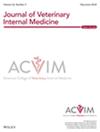Development of a Novel Epilepsy and Dyskinesia Survey for Large-Scale Characterization of Seizure Semiology in Dogs
Abstract
Background
Diagnosing epilepsy and dyskinesia in dogs relies on seizure semiology, laboratory workup, brain imaging, and electroencephalography. Variability in existing epilepsy surveys complicates comparison and impedes epidemiologic and genetic research.
Objective
To characterize the semiology of epileptic seizures and dyskinesia episodes using a novel, owner-completed, multi-language online questionnaire.
Animals
A cohort of 606 dogs from 96 breeds with paroxysmal events, perceived by their owners as epilepsy or dyskinesia.
Materials and Methods
A comprehensive epilepsy and dyskinesia questionnaire featuring pragmatic seizure categories and video upload was developed in German, Finnish, and English. The reliability of the questionnaire was assessed, and the study cohort analyzed.
Results
The questionnaire demonstrated strong internal consistency and interrater agreement. Owners correctly classified paroxysmal events in 90.1% of cases (95% CI 88.18–92.11). Video footage was submitted from 23.8% (143/606) and supported the seizure type in the questionnaire in 96.5%. The age of onset ranged from 6 months to 6 years in 80.2% (median 2 years; IQR 1–5 years). Generalized (epileptic) convulsive seizures occurred in 58.6% of dogs, non-generalized paroxysmal motor events without convulsions in 58.1%, sudden falls without movement in 6.1%, episodes of impaired awareness in 15.8%, and other unclassified events in 7.1%. Multiple seizure types were reported in 25.2% of the dogs. Labrador Retrievers exhibited a higher prevalence of non-generalized motor events compared to Border Collies, Siberian Huskies, and other breeds (p < 0.001).
Conclusions
The questionnaire reliably characterizes epileptic seizures and dyskinesia episodes in dogs, making it a valuable tool for large-scale epidemiological and genetic studies.

 求助内容:
求助内容: 应助结果提醒方式:
应助结果提醒方式:


